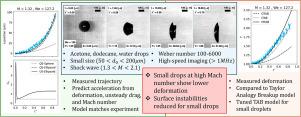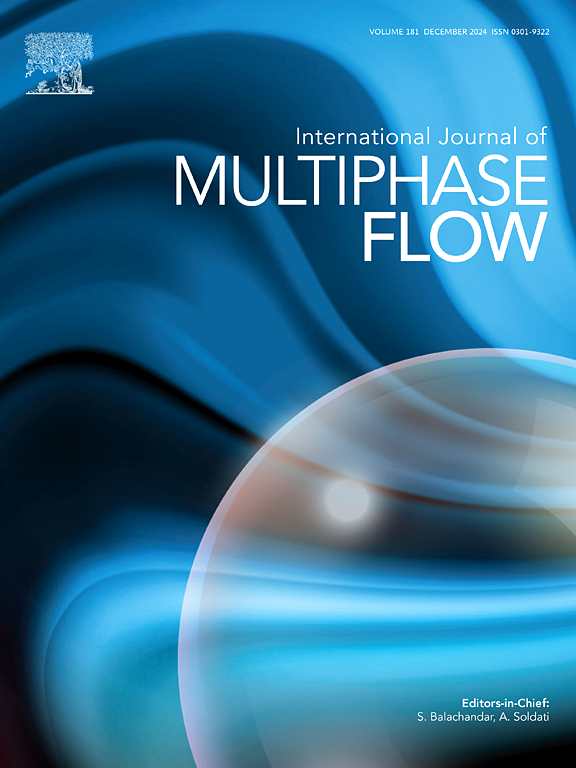小液滴在高速条件下的变形和加速度
IF 3.8
2区 工程技术
Q1 MECHANICS
International Journal of Multiphase Flow
Pub Date : 2025-08-09
DOI:10.1016/j.ijmultiphaseflow.2025.105372
引用次数: 0
摘要
激波驱动的液滴破碎发生在各种物理系统中,在旋转爆震发动机中的液滴燃烧和高超声速飞行器中的液滴撞击等紧急高速飞行应用中起着至关重要的作用。在这些应用中,液滴与强激波相互作用,高激波后的气体速度和温度导致液滴快速加速、蒸发和破裂,通过各种流体动力不稳定性。在这些应用中,对破碎过程的准确预测是必不可少的,并且需要基于理论的模型来覆盖遇到的大参数空间。为了模拟液滴流体动力不稳定性的增长,首先必须知道液滴的加速度和形状,这就需要准确地预测变形和阻力。以前的工作主要集中在较低冲击强度下的大液滴上,那里的加速和蒸发速度要慢得多。在这里,研究了小液滴在强激波加速下直至破裂开始的动力学,重点研究了液滴尺寸、马赫数和蒸发对变形和加速度的影响。激波管实验进行了广泛的参数,包括液滴大小,冲击强度和液体性质。入射激波马赫数为1.35 ~ 2.1,用于直径为~ 50 ~ 200[μm]的微米级液滴。研究了各种流体(水、十二烷和丙酮),得到韦伯数在~ 100-6000之间。以亚微米级的空间分辨率和亚微秒级的时间分辨率测量液滴的变形和位置。提出了对Taylor类比破裂模型的新修正,修正了考虑变形和马赫数效应的阻力相关性,以准确地捕捉液滴动力学。结果与先前的毫米液滴破碎研究结果进行了比较,发现新模型在广泛的条件下捕获了大量液滴变形和阻力。没有观察到蒸发对这些过程有影响,即使是最小的液滴。然而,小液滴的水动力不稳定性增长明显小于大液滴,大液滴在后期的轨迹偏离模型更大。本文章由计算机程序翻译,如有差异,请以英文原文为准。

Deformation and acceleration of small droplets at high-speed conditions
Shock-driven droplet breakup occurs in various physical systems and plays a critical role in emergent high-speed flight applications such as droplet combustion in rotating detonation engines (RDEs) and droplet impacts on hypersonic vehicles. Droplets interact with strong shock waves in these applications, and the high post-shock gas velocity and temperature lead to rapid droplet acceleration, evaporation, and breakup through various hydrodynamic instabilities. Accurate prediction of the breakup process is essential in these applications and theory-based models are required to cover the large parameter space encountered. In order to model the growth of hydrodynamic instabilities on the droplet, the acceleration and droplet shape must be known first, requiring accurate prediction of both deformation and drag. Previous work has largely focused on large droplets at lower shock strengths, where acceleration and evaporation are much slower. Here, the dynamics of small droplets accelerated by strong shock waves are explored up to the onset of breakup, focusing on droplet size, Mach number, and evaporation effects on the deformation and acceleration.
Shock tube experiments are conducted for a wide range of parameters including droplet size, shock strength, and liquid properties. Incident shock wave Mach numbers of 1.35 - 2.1 are used with micron-scale droplets with diameters from to . Various fluids (water, dodecane, and acetone) were studied yielding Weber numbers from . Droplet deformation and position are measured with sub-micrometer spatial resolution and sub-microsecond temporal resolution. New modifications to the Taylor Analogy Breakup model are presented with modified drag correlations accounting for deformation and Mach number effects to accurately capture the droplet dynamics. The results are compared with previous millimeter-droplet breakup studies, finding that bulk droplet deformation and drag are captured by the new models over a wide range of conditions. Evaporation was not observed to effect these processes, even for the smallest droplets. However, small droplets are shown to exhibit significantly less hydrodynamic instability growth than large droplets, which display a larger departure in trajectory from the model at late times.
求助全文
通过发布文献求助,成功后即可免费获取论文全文。
去求助
来源期刊
CiteScore
7.30
自引率
10.50%
发文量
244
审稿时长
4 months
期刊介绍:
The International Journal of Multiphase Flow publishes analytical, numerical and experimental articles of lasting interest. The scope of the journal includes all aspects of mass, momentum and energy exchange phenomena among different phases such as occur in disperse flows, gas–liquid and liquid–liquid flows, flows in porous media, boiling, granular flows and others.
The journal publishes full papers, brief communications and conference announcements.

 求助内容:
求助内容: 应助结果提醒方式:
应助结果提醒方式:


